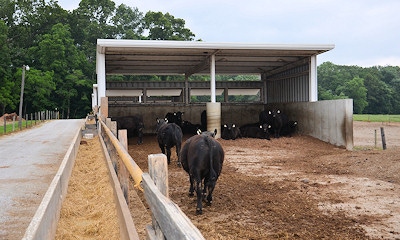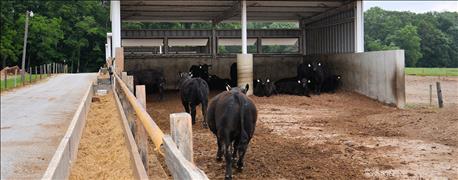
There is only one livestock sale I know of where you get a catalog with no pictures when you request a printed catalog of sale animals. It is the Indiana Bull Test Evaluation program sale. Held twice per year, the 77th sale of bulls that have been evaluated in the bull test program over the past 39 years was held recently at the Springville Feeder Auction facility at Springville. The bulls came off test at the Feldun Purdue Farm near Bedford. The station moved there many years ago after development in the Hamilton County area made it unfeasible to keep the bull test station located near Carmel.

NEW TEST STARTS SOON: The lots at the IBEP test station will soon be home to bulls on the summer test in the program.
Brad Shelton is the station manager of the IBEP Bull Test Station at Feldun Purdue. Here is an exclusive interview with Shelton the day following the sale.
IPF: Brad, how is the sale order determined for this sale?
Shelton: Spelled out in the catalog, each bull is given a within-breed percentile group ranking for many traits, including performance during the test, Expected Progeny Differences and $ indexes. These are broken into 1 to 10% groups, with the best in that category being a 10, and the worst a 1. Seven traits feed into the formula. They come from this list of traits: Average daily gain ration, weight per day of age ration, % retail product, % Intra-muscular fat, direct calving ease EPD, Weaning weight EPD and Maternal milk EPD. If the bull does not have an EPD for direct calving ease, birth weight EPD is used.
The highest possible score is 70. Bulls with the highest score sell first. If two bulls have the same total score, then performance index is the tie breaker. It is figured on average daily gain and weight per day of age vs. the average for the animal’s breed.
Did the highest testing bull bring the most money?
Shelton: No, it sold for $2,500. The second bull sold for $6,000. The top selling bull at $7.500 was toward the middle of the sale.
What were people looking for besides these ratings and performance indexes?
Shelton: Obviously part of it was based on the phenotype of the bull. Others were looking at pedigrees. Some of these bulls had strong pedigrees in their breed.
What was the average selling price for the entire sale?
Shelton: Donna Lofgren at Purdue University is an essential part of the program. She reports that the average selling price was $3,155. It is the fifth highest average since we have held the test and conducted these sales.
Where did the bulls come from?
Shelton: We had breeders from Illinois, Indiana, Kentucky, Michigan, Wisconsin and more who had placed bulls on test, and have bulls in the sale. Buyers were from Indiana, Ohio, Kentucky Illinois and other states.
The top selling bull came in about a third of the way through the sale, bringing $7,500. Why do you think he was in high demand?
Shelton: Blood lines may have been part of it, but he was a stout, attractive bull. He also posted a solid set of EPD numbers for traits, including 10’s, the highest score possible, for weaning weight, yearling weight, maternal milking ability and carcass weight. He had a lot going for him and obviously several people identified him as one they would like to have.
How many bulls will be on the summer test?
Shelton: It is coming together now and we expect at least 80 bulls. It is much smaller because of the timing of when people calve in this area. The next sale for the best of these bulls will be Saturday, October 15 at 2 p.m. EDT at the Springville Feeder Auction.
About the Author(s)
You May Also Like




